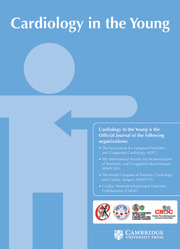No CrossRef data available.
Article contents
The roles of miR-101, miR-1183 and miR-1299 in acute rheumatic fever and rheumatic heart disease
Published online by Cambridge University Press: 03 February 2025
Abstract
Acute rheumatic fever commonly causes carditis in children. It is critical to have biomarkers for diagnostic and prognostic purposes. We aimed to investigate the expressions of miR-101, miR-1183, and miR-1299 in children with acute rheumatic fever and rheumatic heart disease and determine their potential as diagnostic biomarkers.
This cross-sectional study was conducted on 69 paediatric acute rheumatic fever patients and 27 gender and age-matched controls. The clinical findings were noted from medical records, echocardiography was repeated, and plasma miR-101, miR-1183, and miR-1299 expressions were studied using RT-PCR.
Out of 54 patients with carditis, 36 developed rheumatic heart disease with significant left-sided heart involvement. No significant demographic difference was present between rheumatic heart disease patients and controls (p > 0.05). miR-101 and miR-1183 expressions significantly reduced by 4.5-fold in acute rheumatic fever patients compared to controls (p : 0.029 and p : 0.024, respectively). Family history was found to be significantly associated with 9-fold reduced miR-1183 expression in acute rheumatic fever patients (p : 0.005). The expression of miR-1183 in acute rheumatic fever children with carditis in general and severe carditis was significantly reduced 4.5- and 9-fold, respectively (p : 0.024 and p : 0.007, respectively). In acute rheumatic fever cases with moderate-severe carditis and patients who did not develop rheumatic heart disease, miR-1183 expression significantly reduced 8.3-fold and 9-fold, respectively (p : 0.015 and p : 0.019, respectively). The ROC analysis revealed that miR-101 and miR-1183 were statistically significant for acute rheumatic fever diagnosis (AUC: 0.64 for both miRNAs).
Significantly lower plasma expressions of miR-101 and miR-1183 in acute rheumatic fever patients, especially in cases with moderate-severe carditis, might indicate the potential use of these miRNAs as diagnostic biomarkers.
- Type
- Original Article
- Information
- Copyright
- © The Author(s), 2025. Published by Cambridge University Press



